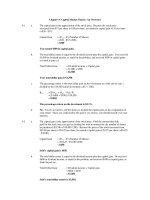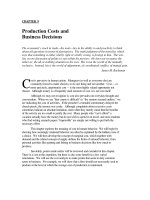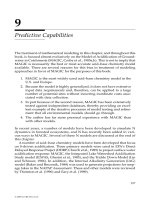HRM 5th chapter 9 managing compensation
Bạn đang xem bản rút gọn của tài liệu. Xem và tải ngay bản đầy đủ của tài liệu tại đây (1.05 MB, 49 trang )
Managing
Compensation
Managing Human Resources
Belcourt * Bohlander * Snell
5th Canadian edition
PowerPoint Presentation by
Copyright © 2008 by Nelson, a division of Thomson
Canada Limited. All rights reserved.
Monica Belcourt, York University and
Charlie Cook, The University of West Alabama
Objectives
After studying this chapter, you should be able to:
1. Explain employer concerns in developing a strategic
compensation program.
2. Indicate the various factors that influence the
setting of wages.
3. Differentiate the mechanics of each of the major
job evaluation systems.
4. Explain the purpose of a wage survey.
5. Define the wage curve, pay grades, and rate
ranges as parts of the compensation structure.
Copyright © 2008 by Nelson, a division of Thomson Canada Ltd.
9–2
Objectives
(cont’d)
After studying this chapter, you should be able to:
6. Identify the major provisions of the laws and
regulations affecting compensation.
7. Discuss the current issues of equal pay for work of
equal value and pay compression.
Copyright © 2008 by Nelson, a division of Thomson Canada Ltd.
9–3
Compensation
• Pay is a statement of an employee’s worth by
an employer.
• Pay is a perception of worth by an employee.
Copyright © 2008 by Nelson, a division of Thomson Canada Ltd.
9–4
Total
TotalCompensation
Compensation
Direct
Direct
Indirect
Indirect
Wages
Wages//Salaries
Salaries
Time
TimeNot
NotWorked
Worked
Commissions
Commissions
Bonuses
Bonuses
Gainsharing
Gainsharing
••Vacations
Vacations
••Breaks
Breaks
••Holidays
Holidays
Insurance
InsurancePlans
Plans
••Medical
Medical
••Dental
Dental
••Life
Life
Security
SecurityPlans
Plans
• •Pensions
Pensions
Employee
EmployeeServices
Services
••Educational
Educationalassistance
assistance
••Recreational
programs
Recreational programs
Copyright © 2008 by Nelson, a division of Thomson Canada Ltd.
9–5
Compensation Management and
Other HRM Functions
Aid
Aidor
orimpair
impairrecruitment
recruitment
Recruitment
Recruitment
Supply
Supplyof
ofapplicants
applicants
affects
wage
affects wagerates
rates
Pay
Payrates
ratesaffect
affectselectivity
selectivity
Selection
Selection
Selection
Selectionstandards
standardsaffect
affect
level
of
pay
required
level of pay required
Pay
Paycan
canmotivate
motivatetraining
training
Training
Trainingand
and
Development
Development
Increased
Increasedknowledge
knowledgeleads
leads
to
higher
pay
to higher pay
Training
Compensation
Trainingand
anddevelopment
developmentmay
may Compensation
lead
Management
leadto
tohigher
higherpay
pay
Management
Low
Lowpay
payencourages
encourages
unionization
unionization
Copyright © 2008 by Nelson, a division of Thomson Canada Ltd.
Management
AAbasis
basisfor
fordetermining
determining
employee’s
employee’srate
rateof
ofpay
pay
Labour
Labour
Relations
Relations
Pay
Payrates
ratesdetermined
determined
through
negotiation
through negotiation
9–6
Strategic Compensation Planning
• Strategic Compensation Planning
Links the compensation of employees to the mission,
objectives, philosophies, and culture of the
organization.
Serves to mesh the monetary payments made to
employees with specific functions of the HR program
in establishing a pay-for-performance standard.
Seeks to motivate employees through compensation.
Copyright © 2008 by Nelson, a division of Thomson Canada Ltd.
9–7
Linking Compensation to Organizational
Objectives
• Value-added Compensation
Evaluating the individual components of the
compensation program (pay and benefits) to see if
they advance the needs of employees and the goals
of the organization.
“How does this compensation practice benefit the
organization?”
“Does the benefit offset the administrative cost?”
Copyright © 2008 by Nelson, a division of Thomson Canada Ltd.
9–8
Common Strategic Compensation Goals
1. To reward employees’ past performance
2. To remain competitive in the labour market
3. To maintain salary equity among employees
4. To mesh employees’ future performance with
organizational goals
5. To control the compensation budget
6. To attract new employees
7. To reduce unnecessary turnover
Copyright © 2008 by Nelson, a division of Thomson Canada Ltd.
9–9
Strategic Compensation Policy Concerns
1. The rate of pay within the organization and whether it is to be
above, below, or at the prevailing community rate.
2. The ability of the pay program to gain employee acceptance
while motivating employees to perform to the best of their
abilities.
3. The pay level at which employees may be recruited and the
pay differential between new and more senior employees.
4. The intervals at which pay raises are to be granted and the
extent to which merit and/or seniority will influence the raises.
5. The pay levels needed to facilitate the achievement of a sound
financial position in relation to the products or services
offered.
Copyright © 2008 by Nelson, a division of Thomson Canada Ltd.
9–10
The Pay-for-Performance Standard
• Pay-for-Performance Standard
The standard by which managers tie compensation to
employee effort and performance.
Refers to a wide range of compensation options,
including merit-based pay, bonuses, salary
commissions, job and pay banding, team/ group
incentives, and various gainsharing programs.
Copyright © 2008 by Nelson, a division of Thomson Canada Ltd.
9–11
Designing a Pay-for-Performance System
• How will performance be measured?
• How will monies to be allocated for
compensation increases.
• Which employees will be eligible?
• How will payouts be made?
• How often will payouts occur?
• How large will the payouts be?
• Will employees perceive the rewards as valued?
Copyright © 2008 by Nelson, a division of Thomson Canada Ltd.
9–12
Motivating Employees through
Compensation
• Pay Equity
An employee’s perception that compensation
received is equal to the value of the work performed.
A motivation theory that explains how people respond
to situations in which they feel they have received
less (or more) than they deserve.
Individuals form a ratio of their inputs to outcomes in
their job and then compare the value of that ratio with
the value of the ratio for other individuals in similar jobs.
Copyright © 2008 by Nelson, a division of Thomson Canada Ltd.
9–13
Relationship between Pay Equity and Motivation
Doing More and Receiving Less
Doing the Same and Receiving the Same
Doing Less and Receiving More
The greater the perceived disparity between my input/output ratio and
the comparison person’s input/output ratio, the greater the motivation
to reduce the inequity.
Figure 9.1
Copyright © 2008 by Nelson, a division of Thomson Canada Ltd.
9–14
Expectancy Theory and Pay
• Expectancy Theory
A theory of motivation that holds that employees
should exert greater work effort if they have reason to
expect that it will result in a reward that they value.
Employees also must believe that good performance
is valued by their employer and will result in their
receiving the expected reward.
Copyright © 2008 by Nelson, a division of Thomson Canada Ltd.
9–15
Pay-for-Performance and Expectancy Theory
Figure 9.2
Copyright © 2008 by Nelson, a division of Thomson Canada Ltd.
9–16
Motivating Employees through
Compensation
• Pay Secrecy
An organizational policy prohibiting employees from
revealing their compensation information to anyone.
Creates misperceptions and distrust of compensation
fairness and pay-for-performance standards.
Arguments against secrecy:
Knowledge of base pay is the strongest predictor of pay
satisfaction, which is highly associated with work
engagement.
Knowledge of base pay more strongly predicts pay
satisfaction than does the actual amount of pay received by
employees.
Copyright © 2008 by Nelson, a division of Thomson Canada Ltd.
9–17
The Bases for Compensation
• Hourly Work
Work paid on an hourly basis.
• Piecework
Work paid according to the number of units produced.
• Salary Workers
Employees whose compensation is computed on the
basis of weekly, biweekly, or monthly pay periods.
Copyright © 2008 by Nelson, a division of Thomson Canada Ltd.
9–18
Factors Affecting the Wage Mix
Figure 9.3
Copyright © 2008 by Nelson, a division of Thomson Canada Ltd.
9–19
The Wage Mix—Internal Factors
• Employer’s Compensation Strategy
Setting organization compensation policy to lead, lag,
or match competitors’ pay.
• Worth of a Job
Establishing the internal wage relationship among
jobs and skill levels.
• Employee’s Relative Worth
Rewarding individual employee performance.
• Employer’s Ability-to-Pay
Having the resources and profits to pay employees.
Copyright © 2008 by Nelson, a division of Thomson Canada Ltd.
9–20
Highlights in HRM
Comparison of Compensation Strategies
Highlights 9.1
Copyright © 2008 by Nelson, a division of Thomson Canada Ltd.
9–21
The Wage Mix—External Factors
• Labour Market Conditions
Availability and quality of potential employees is
affected by economic conditions, government
regulations and policies, and the presence of unions.
• Area Wage Rates
A firm’s formal wage structure of rates is influenced
by those being paid by other area employers for
comparable jobs.
Copyright © 2008 by Nelson, a division of Thomson Canada Ltd.
9–22
The Wage Mix—External Factors
• Cost of Living
Local housing and environmental conditions can
cause wide variations in the cost of living for
employees.
Inflation can require that compensation rates be
adjusted upward periodically to help employees
maintain their purchasing power.
Copyright © 2008 by Nelson, a division of Thomson Canada Ltd.
9–23
The Wage Mix—External Factors
• Collective Bargaining
Escalator clauses in collective agreements provide for
quarterly upward cost-of-living wage adjustments for
inflation to protect employees’ purchasing power.
Unions bargain for real wage increases that raise the
standard of living for their members.
Real wages are increases larger than rises in the
consumer price index; that is, the real earning power
of wages.
Copyright © 2008 by Nelson, a division of Thomson Canada Ltd.
9–24
Consumer Price Index (CPI)
• A measure of the average
change in prices over time in a
fixed “market basket” of goods
and services
Copyright © 2008 by Nelson, a division of Thomson Canada Ltd.
9–25









